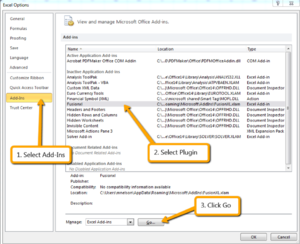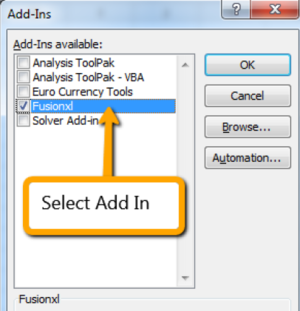FusionXL Install
Overview
FusionXL consists of a single XLAM file which can be installed into Microsoft Excel® as an add-in.
Once installed, Excel will display a new Tab on the Ribbon titled ‘FusionXL’. FusionXL will need to be configured to connect to a Fusion Registry. This document details how to install the plugin in Microsoft Excel as well as how to connect to a Fusion Registry.
FusionXL is compatible with Microsoft Excel 2010 and later
Enabling the Plugin
There are two methods to enable the plugin in Excel. Both include copying the file to a plugin directory in your file system. In both cases the file is placed in a subfolder of ‘AppData’ which is a hidden folder, therefore you will first need to enable Windows Explorer to be able to view hidden files and folders.
Both options are discussed below.
XLSTART
The first option is to place the plugin into the XLSTART directory then FusionXL will be available the next time you launch Excel. To do this, place the FusionXL.xlam file into the following directory (note that the path may vary on different Operating Systems).
C:\Users\[your user name]\AppData\Roaming\Microsoft\Excel\XLSTART
Once Excel Starts the Fusion Browser tab will now be available.
AddIns
The second option is to place the FusionXL.xlam file into the AddIns folder. This folder allows for plugins to be provided to a single location, but they can be separately enabled or disabled from within Microsoft Excel. Using the AddIns folder requires two steps: 1. Copying the file into the AddIns folder 2. Enabling the FusionXL add-in from within Excel
First, you will need to locate your AddIns folder. On Windows 7, this is located under your home folder in the following location:
C:\Users\[your user name]\AppData\Roaming\Microsoft\AddIns
Note: this folder may be in a different location on different versions of Windows and in non-standard installations. Please check with your system administrator if you cannot find this folder. Copy the file FusionXL.xlam file into this directory and then launch Excel. From within Excel, open the Excel Options menu, and select Add-Ins.
After clicking ‘Go’ an Add-Ins window will be displayed which will show “FusionXL” as an available add-in. Select this add-in and click ‘OK’.
After clicking ‘OK’ the Add-Ins window will close and the ‘FusionXL’ tab will be added to the Excel Ribbon. This tab will be available on all subsequent launches of Excel from this computer, unless the add-in is disabled from the add-ins menu (or the .xlam file is deleted from the file system).
The resulting FusionXL tab will be displayed in the Ribbon
Connection to a Fusion Registry
The first step is to then set up a connection to a Fusion Registry. This is achieved by clicking the ‘Setup Connections’ button. A dialog will be displayed (see Figure 4) allowing the entry of up to 5 distinct URLs. Each URL should reference a valid Fusion Registry instance, and have a unique alias.
Example URLs are:
https://demo.metadatatechnology.com/FusionRegistry/ (Metadata Technology demo Registry)
https://registry.sdmx.org/ (SDMX Global Registry)
On clicking Ok, the selected connection will be verified, and the dialog will be closed.
To select which Registry Fusion Excel is communicating with, a user can simply using the drop down control on the Excel Ribbon (under the newly added FusionXL tab)
Below the drop-down control to select the Fusion Registry, is another drop-down allowing the user to switch between “Structure Explorer” and “Data Explorer”. Please note that the data control is only available when communicating which a Fusion Registry of version 9 or above.
The login control allows the user to login to the specified Registry if they have the correct credentials. A non-logged in user is able to view the contents of the Registry, but a user must be logged in if they wish to modify structures in the structure explorer.


